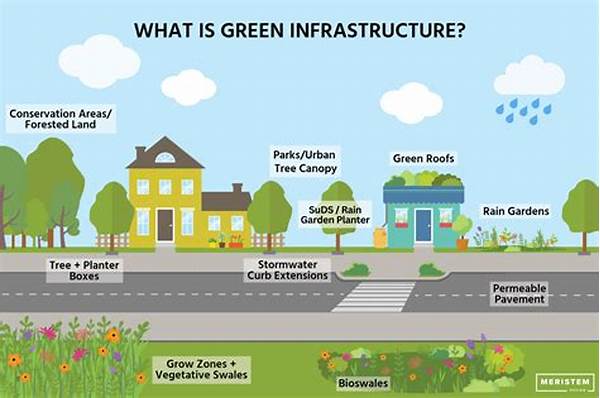Once upon a time, in a bustling city struggling to balance its concrete jungle and the beauty of Mother Nature, visionary minds embarked on a journey—a mission to change the city’s landscape and breathe life back into the urban sprawl. They called it the “green infrastructure development plans.” Word spread like wildfire, and everyone was buzzing with excitement over what this plan could bring. The city’s heart skipped a beat as people imagined lush parks and streets lined with shady trees, making the city a better place for everyone, from skateboarders to stroller pushers.
Read Now : Sustainable And Affordable Garden Tips
Going Green: Transforming Cityscapes
The green infrastructure development plans were set to revolutionize urban living, paving the way for a sustainable future. Picture it: towering skyscrapers softened by vertical gardens, rooftops flaunting lively green spaces, and rain gardens popping up like wildflowers on formerly barren lots. This wasn’t just a pipe dream; it was a full-blown movement. Urban planners and eco-warriors joined forces, creating a symphony of green solutions. The goal? Connect people with nature, reduce urban heat, and cut down pollution while encouraging healthier lifestyles. It was a massive undertaking, and everyone from teens with their reusable water bottles to elders reminiscing on park benches joined in, eager to leave behind a vibrant world for future generations.
Hurdles and Challenges in Going Green
1. Money Talks: Let’s face it, the green infrastructure development plans were gonna cost some serious dough. But hey, good things don’t come cheap, right?
2. Red Tape Tango: Navigating the labyrinth of regulations was like dancing cha-cha in quicksand. Slow and frustrating but necessary!
3. Community Cluelessness: Not everyone was on the green train; getting the peeps on board took some big-time convincing.
4. Maintenance Mayhem: Throwing a bunch of plants around is one thing; keeping them alive is another! Regular TLC was essential.
5. Space Invaders: Fitting parks and greenery in a cramped city was a puzzle only the sharpest minds could solve.
Implementing the Vision: Neighborhood by Neighborhood
The launch of the green infrastructure development plans took the city by storm. Each neighborhood dove into its unique transformation. Streets known for endless traffic jams started sprouting bike lanes, and alleys infamous for their dullness turned into pop-up gardens. Kids swapped video game marathons for tree climbing competitions, and pets trotted along well-maintained green pathways. The change was palpable; optimism filled the air. Little by little, concrete met its match as nature crept in, proving coexistence was not just possible but beautiful.
With folks rallying around the green cause, local businesses saw opportunities sprouting up too. Cafés featured organic options, while shops jumped on the bandwagon, offering eco-friendly products. These businesses thrived, embraced by an eager community. The metropolis was evolving, adapting, and, most importantly, breathing.
Read Now : Economical Urban Housing Programs
Evolution of Urban Dreams
Under the umbrella of green infrastructure development plans, the city was evolving. What started as mere whispers of change turned into roars of progress echoing in every neighborhood. These plans were not just about infrastructure; they were about identity, revolutionizing how city dwellers perceived their place in the world. People were living more mindfully, weaving eco-consciousness into their daily routines. Spaces once dominated by pollution and neglect blossomed into green havens, becoming city jewels. The excitement was contagious, as residents felt they were part of something grander than themselves—a legacy of sustainability and community.
Future Outlook: A City Transformed
As the green infrastructure development plans moved forward, each success was a stepping-stone toward more ambitious goals. What started as grassroots efforts had grown into a movement, rewriting the urban landscape. It was an era where communal pride and environmentalism walked hand in hand, shaping a city without compromising nature’s integrity. The initiative wasn’t just reshaping the layout, but also the mindset, turning urbanites into stewards of the earth. This was the dawn of a greener society, a testament to what folks could achieve when they pulled together for the planet and each other. Every green patch added was a step toward a thriving, sustainable ecosystem.
Celebrating Success: A Green Legacy
Looking back on the journey, the city celebrated its wins, big and small. The green infrastructure development plans left an indelible mark on the metropolis—a tale of perseverance, adaptation, and unyielding hope. These stories of transformation served as blueprints for other cities dreaming of their green revolutions. Indeed, nature’s embrace was now tightly woven into the city’s fabric, standing as a beacon for future pathfinders. Forever changed, this was more than just a city initiative; it was a promise to all city dwellers that the future was here, and it was gloriously green.
A Greener Tomorrow: Community Insights
Peering into the green infrastructure development plans, one couldn’t ignore the stories unfolding in the grassroots. These were tales of individuals embracing change, sharing inspirations on social media, and hosting local green fairs. Collective efforts became shared victories, weaving community spirit into the environmental narrative. Urban tales spoke of aged trees offering shade to new generations, and parks healing disconnected societies. These personal stories painted the larger canvas, highlighting a hopeful, enduring legacy, leaving no doubt that once fragmented neighborhoods now thrived lush with unity and promise.
Final Reflections
To summarize the green infrastructure development plans, picture a whirlwind of inspiration leaving footprints across a once-gray cityscape. This isn’t a swan song but a melody that residents hummed daily, a historical chapter marked by determination. The movement was about creating equilibrium, finding beauty in harmony with nature, and celebrating everyday victories. In essence, the plans had not just reshaped the terrain but nurtured the soul of the city. This was a renaissance, a resurgence of greenery, building a cityscape bathed in emerald light—a commitment both to the earth and its people.
